If any place on the planet is designed for skiing, it’s Colorado. And it didn’t take early settlers long to discover it. It is thought that skis were first used in a mining camp along the Blue River near present-day Breckenridge during the winter of 1859–60. Father John L. Dyer, the most famous of the 50 or so stalwarts contracted to carry mail over the mountains, used skis to deliver letters and the word of God to remote mining camps.
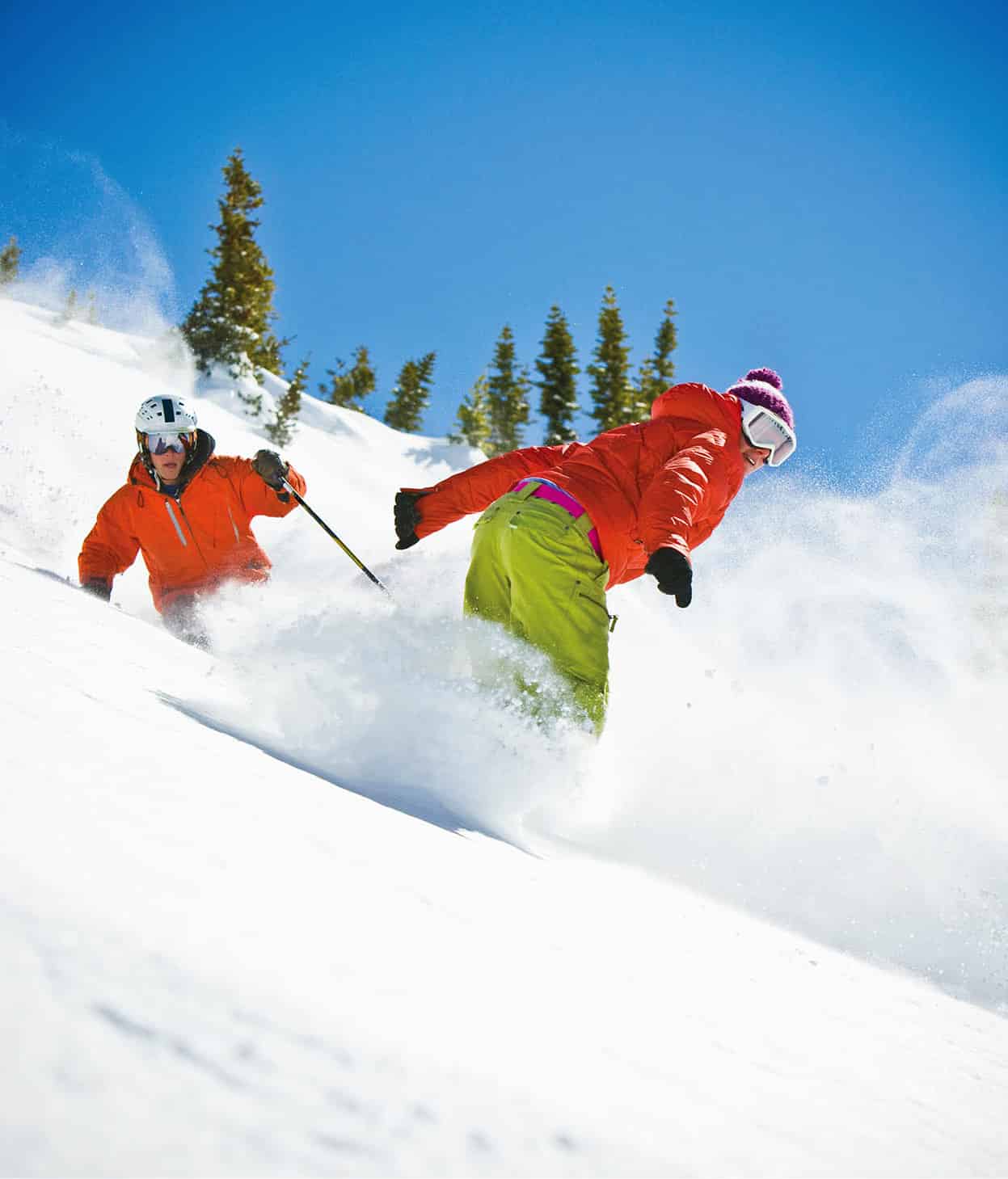
Perfect powder at Aspen.
Getty Images
Miners from Irwin and Crested Butte challenged each other to downhill races as early as 1886. In 1911, Norwegian ski jumper Carl Howelsen – dubbed the “Flying Norseman” during a brief stint with Barnum & Bailey’s circus – thrilled crowds in Hot Sulphur Springs by soaring 79ft (24 meters) through the air. Two years later, when Denver was blanketed by one of the worst blizzards of the century, Howelsen and a handful of other skiers impressed local sportsmen by sliding down Capitol Hill. The episode inspired the formation of the Denver Rocky Mountain Ski Club, which soon became an avid promoter of the sport.
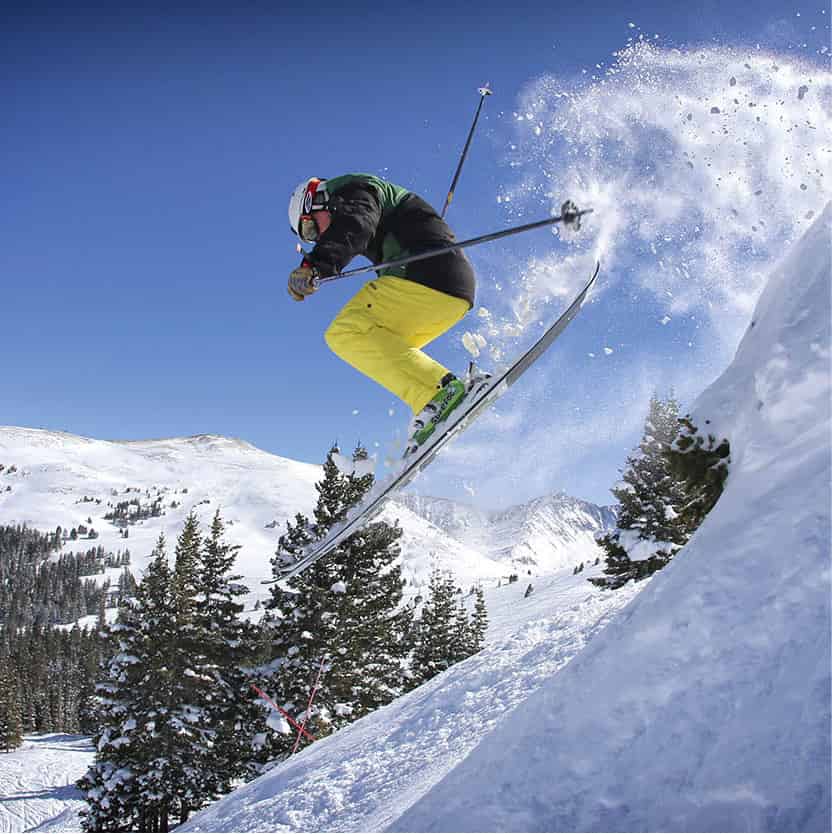
Skier at Copper Mountain.
Tripp Fay, Copper Mountain
Birth of an idea
It wasn’t until the 1930s, however, that the concept of the “ski area” came into its own, thanks largely to the advent of the rope tow, which had its Colorado debut at Berthoud Pass in 1937. The first chair-lift, constructed in the fashion of a mining tram, was installed at the Pioneer Ski Area near Crested Butte in 1939. Colorado’s first double chair-lift was erected nine years later at Berthoud Pass. World War II naturally put a hold on ski area development, but not on skiing. Thousands of “ski troops” were trained at Camp Hale near Leadville during the war. Afterwards, veterans of the camp’s 10th Mountain Division were a prime force in creating the post-war ski boom.
Soldiers on skis
Taking a cue from the snow-savvy Finns and Scandinavians who had outmaneuvered their respective Russian and German antagonists in winter hostilities, the US military decided in mid-1941 to create its own special fighting force. General George C. Marshall gave the go-ahead to a project that would give birth to the storied 10th Mountain Division – and, indirectly, the Colorado skiing industry as we know it.
The site the Army chose as a training center was an obscure place named Pando, high up in the heart of the Colorado Rockies. Here, in a mountain valley 6 miles (10km) north of Leadville, was established Camp Hale. From it would emerge an entire division of troops trained to ski, climb, and fight in harsh weather and on rugged turf by a cadre of mixed American and European experts.
There was plenty of frostbite and other ailments before the 10th Division was put to the test in Italy, starting in November 1944. Its warriors engaged in a series of encounters with Nazi forces in the Po Valley as they cleared a path for the US Army stretching north to the Alps. The cost was high: 992 American war deaths.
The division was eventually disbanded in October 1945. But fond memories of life in Colorado, augmented by a strong bond among comrades, brought many back. They carved out new lives in a skiing industry they did so much to energize.
The Colorado ski industry is no.1 in the nation and contributes $4.8 billion annually to Colorado tourism. Twenty-five full-fledged ski areas and resorts operate in the state and attracted 12.6 million skier visits for the 2013–14 season, a rise of 10 percent over the previous season, thanks to an early start, a late finish, drought in California, and steady snowfall. Preliminary figures for 2016 show increased skier visits of 5 percent; Colorado now accounts for 24 percent of all skier visits in the US. Choices range from low-key ski centers, where prices are moderate and the atmosphere is relaxed, to ritzy, world-class resorts, where the facilities are state-of-the-art, the clientele is chic, and the prices are stratospheric. Regardless of size, they all enjoy some of the world’s finest snow conditions. Winter storms barrel down on the Rockies from the Pacific, losing moisture over the deserts of Utah, Nevada, and Arizona, before unloading tons of light, dry powder on Colorado. What Mother Nature is slow to deliver, technology provides. Snowmaking systems at most ski areas ensure an early start to the season and, coupled with expert grooming, an adequate surface throughout the winter.

Skiers with wooden skis and a single pole at Steamboat Springs, c.1916.
Denver Public Library, Western History Collection
Large or small, just about every ski area offers runs for skiers of all abilities, halfpipes and terrain parks for snowboarders and freeriders, rental equipment, instruction, day care, and a ski patrol trained in rescue and first aid. Major ski areas may have larger and faster chair-lifts than their smaller counterparts (and perhaps a gondola or two), but everything else is merely a matter of scale. What you’ll find at the biggest and most elaborate resorts – and here we’re talking about world-class destinations like Aspen, Vail, Steamboat, and Telluride – is vertical drops of 2,500 to 4,400ft (750–1,350 meters), high-capacity lifts that speed thousands of skiers up the slopes, lodgings for thousands of vacationers and a rollicking après-ski scene. The giants among them rack up a million or more skier visits every winter and are popular summer resorts. Those closest to Denver, including Keystone, Breckenridge, Copper Mountain, Vail, and Winter Park, are jammed with both day-skiers and vacationers. Others are far enough afield to be purely destination resorts.
The Colorado ski season extends over an extraordinary eight months a year. It starts in late October or early November, when Arapahoe Basin and Loveland compete for first-to-open honors, and finishes in June or even July, though most skiers agree that prime time is between Thanksgiving and Easter. Prices for lift tickets and lodging vary widely depending on when you go. Expect the best deals early and late in the season as well as in January. The Christmas holiday and Presidents Week (in late February) command the highest prices and biggest crowds.
The I-70 corridor
Driving west out of Denver along Interstate 70, the first major ski area west of the Eisenhower Tunnel is Keystone. Established in 1970, it burst on the scene with a network of mostly mild runs etched through the trees, a brand-new luxury hotel that stood in sharp contrast to the primitive ski lodgings of the day and, soon after, clusters of condominiums tucked into the woods. Keystone’s trail system now has 135 runs on 3,148 skiable acres (1,274 hectares) spread across three mountains. It has 20 lifts and two high-speed gondolas, and is the state’s only major destination to offer night skiing on a large scale. Keystone Lodge, an early bastion of ski-country luxury, has been refurbished more than once over the years and is still a fine place to stay.
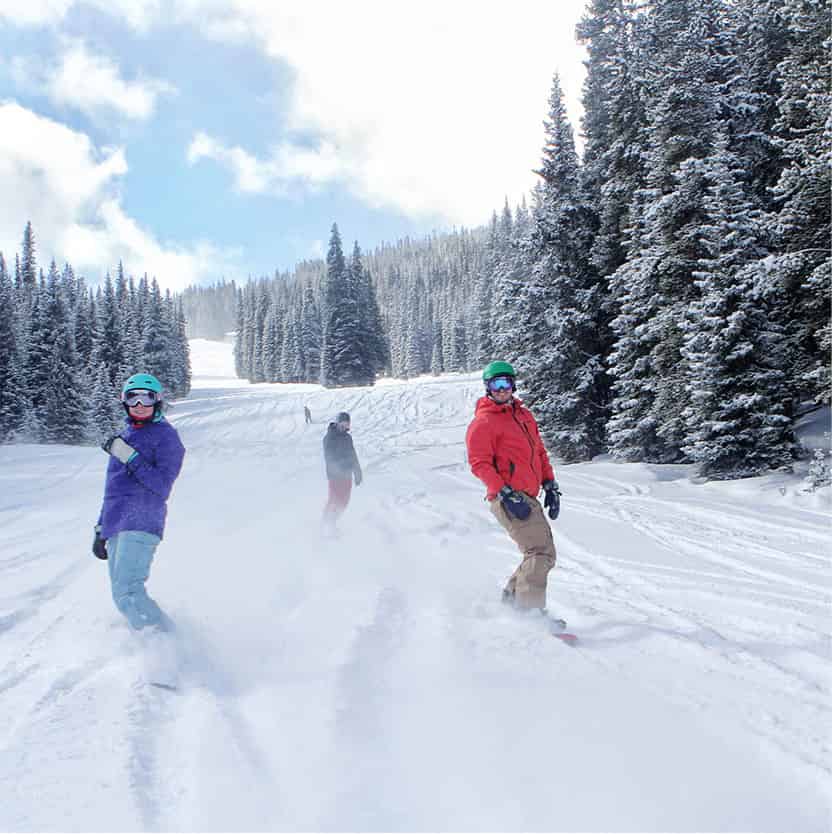
Snowboarders at Copper Mountain.
Tripp Fay, Copper Mountain
Next is the exit for Breckenridge, a 19th-century gold-mining boomtown set against the soaring 10 Mile Range – a dramatic north–south chain of 10 mountains named Peak 1 through Peak 10. When it opened in 1961, with one double chair-lift and a short T-bar, Breckenridge welcomed 17,000 skiers during the first season. Today, it hosts the same number on a busy Saturday. In 1981, Breckenridge installed the world’s first detachable quad chair-lift which, with a capacity of 2,800 skiers per hour, is credited with launching the sport’s high-speed quad revolution. Three years later, “Breck” became Colorado’s first major resort to allow snowboarding. Another lift innovation followed in 1999 with the installation of a double-loading, six-passenger chair-lift.
Copper Mountain, directly south of I-70, was developed 10 years after Breckenridge. Like Keystone, it was a built-from-scratch ski resort, with lodging as well as lifts. Its mountain and big backside bowl regularly win kudos for their intelligent layout, and its resort base has been totally remade in the successful formula developed by corporate giant Intrawest, which acquired it in 1997.
Colorado Ski and Snowboard Museum and Hall of Fame in Vail chronicles the history of Rocky Mountain skiing, from postmen who trekked over mountain passes on primitive skis in the mid-1800s to 21st-century Olympic hopefuls.
Mighty Vail
Farther along I-70 is Vail, America’s largest ski area in terms of skiable acreage and lift capacity, and arguably its most successful resort. Vail was the brainchild of 10th Mountain Division veterans Pete Seibert, Bill “Sarge” Brown and Bob Parker, who shared an audacious vision for a grand, European-style resort. When Vail opened in 1962 with the nucleus of an Alpine-style village, a long four-passenger gondola, two chair-lifts, and a Pomalift, it became the most talked-about ski area in the country. Skiers haven’t stopped talking since – or visiting.
Vail’s mammoth ski terrain stretches 7 miles (11km) from east to west, and encompasses nearly 5,300 acres (2,200 hectares), 36 lifts (14 of them high-speed quads) with a mind-boggling hourly lift capacity of 51,781, and snowriding on 193 named trails. In addition to frontside runs cut through the trees, Vail has seven side-by-side backside bowls. Across the valley is Blue Sky Basin, added in the winter of 1999–2000. Vail Village takes in half a dozen development pods on both sides of I-70, and what is now known promotionally as the Vail Valley stretches all the way from the west side of Vail Pass to Edwards. Vail is just about as far from Denver as most people are willing to drive for a day skiing.
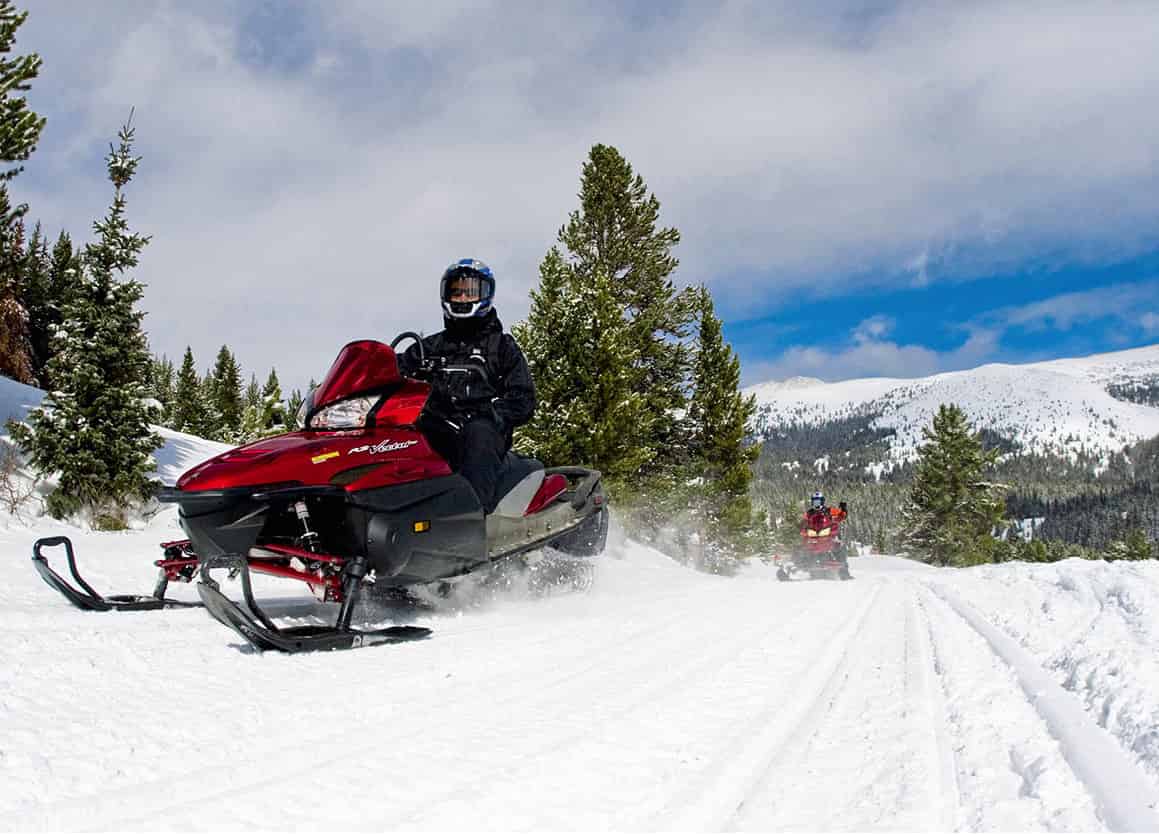
Snowmobiling through the forests near Vail.
Colorado Tourism/Matt Inden
Beaver Creek, 10 miles (16km) to the west, was to have been developed for the 1976 Winter Olympics. Colorado refused the Games, however, giving time for the Beaver Creek plan to mature. Since it opened in 1980, Beaver Creek has grown into the state’s most up-market resort, with gated entrances, monumental architecture, and some of the most pleasant cruising terrain in Colorado. The resort’s legal beagles copyrighted the term “village-to-village skiing” in order to stress that its three lodging “villages” – Beaver Creek, Bachelor Gulch, and Arrowhead – are connected by trails, a fairly unusual arrangement in the United States.
Crisscrossing Colorado
With hundreds of miles of groomed trails and virtually limitless backcountry terrain, Colorado is perfect for cross-country skiers. There are 17 Nordic centers and three guest ranches that offer groomed trails for both cross-country skiers and snowshoers and access to challenging backcountry terrain. Most have classes for skiers of all levels, as well as nature tours and guided treks. For information, contact Nordic Ski Colorado (2810 Hawthorne Avenue, Grand Junction, CO 81506; www.crosscountryskicolorado.com). Alternatively, several dude ranches trade horses for skis during the winter months, and also offer sleigh rides, sledding, and horseback riding. Most of the ranches are surrounded by thousands of acres of national forest.
For multiday journeys there’s a network of 34 cabins linking 350 miles (560km) of backcountry in the Central Rockies, between Aspen, Crested Butte, Leadville, and Vail, and throughout the San Juan Mountains of the Southern Rockies. Known as hut-to-hut travel, trekking between huts requires both navigation skill and skiing ability; skiers with less experience tend to spend one or more nights in a single hut rather than travel from one to another. For further information, contact the 10th Mountain Division Hut Association, 1280 Ute Ave, Suite 21, Aspen, CO 81611; tel: 970-925-5775; www.huts.org.
Winter Park and Steamboat
If you exit I-70 at Empire and head north over Berthoud Pass, you come to Winter Park Resort, popular with both vacationers and day-trippers. This is the only resort in the Rockies served by a dedicated “ski train,” which departs from Union Station in Denver. Winter Park’s 3,0810 skiable acres (1,247 hectares) encompass four summits, 143 runs and 26 lifts. Groswold Discovery Park is an exceptional beginner area, situated well up the mountain but isolated from faster skiers and snowboarders. The Mary Jane sector offers legendary mogul-dotted steeps, Parsenn Bowl has gobs of high-elevation powder, and the Cirque offers fly-on-the-wall pitch.
Silverton Mountain, anti-resort
The biggest little ski area in America, Silverton Mountain is not your average resort. It opened in 2000, the antithesis of the mega-resorts that sprawl across the Rocky Mountains. This backcountry ski area is best defined by what it does not have – no conventional amenities, no novice or intermediate terrain, no trail map, no ski school, no frills. Naturally, it quickly developed a cult following among some of the best skiers and snowboarders in the land. It adjoins Silverton, a charming Victorian mining town filled with character, reached via narrow-gauge railway or the winding San Juan Skyway from Durango.
Far to the northwest, Steamboat occupies a beautiful west-facing massif near the Wyoming state line. The resort’s marketing department coined the phrase “champagne powder” to describe the deep, soft snow that accumulates on broad slopes and drifts into aspen glades. Steamboat’s pioneering Kids Ski Free program lures thousands of families. The traditional ranching town of Steamboat Springs is just 3 miles (5km) from the sprawling resort at the base of the mountain.
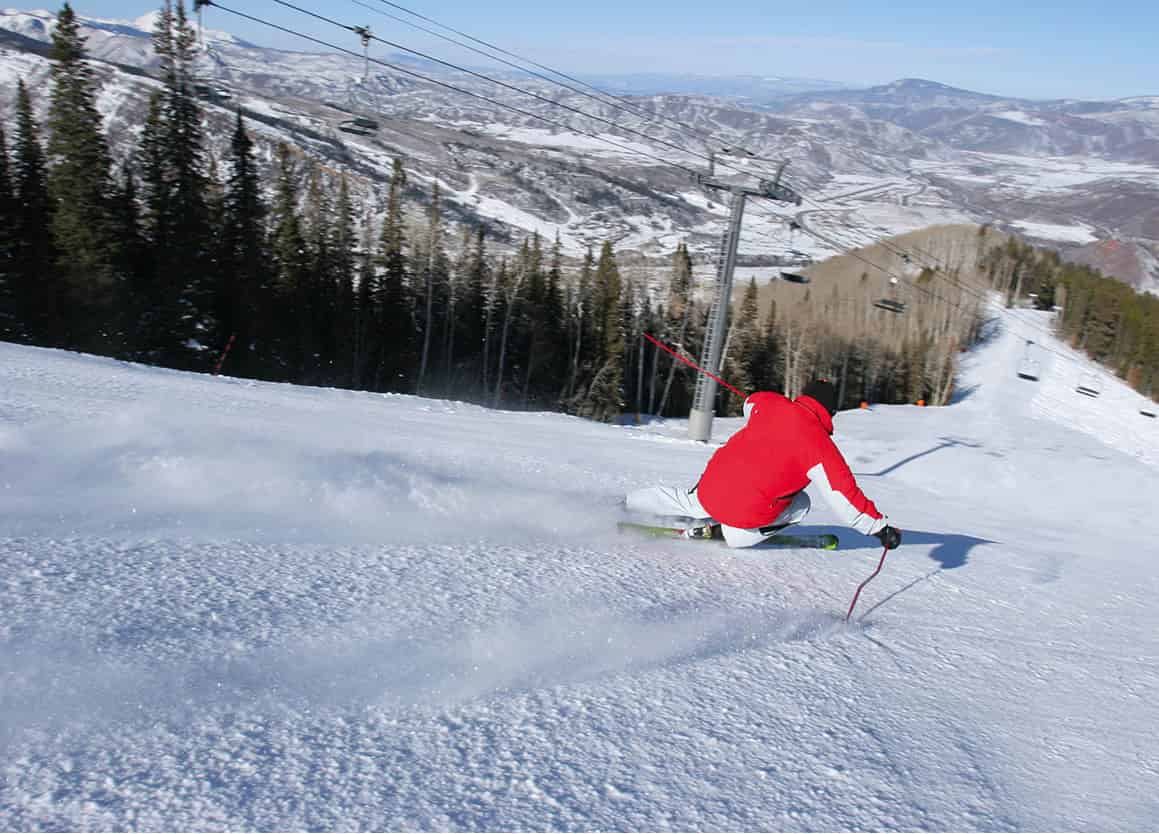
The steep slopes of Aspen.
Dreamstime
Ski Country, Incorporated
The consolidation rampant in corporate America has invaded ski country, providing capital for large-scale improvements at big resorts but homogenizing the ski experience. Vancouver-based Intrawest developed Keystone’s Village at River Run and owns Steamboat Ski and Resort and Winter Park. Vail Resorts, Inc., operates lodging and all on-mountain facilities at Vail, Beaver Creek, Breckenridge, and Keystone, as well as Colorado Mountain Express and RockResorts Hotels. Aspen Skiing Company controls on-mountain facilities at Aspen Mountain, Buttermilk, Aspen Highlands, and Snowmass, and operates some Aspen lodging.
Aspen and Crested Butte
Among skiers, “Aspen” refers to four ski areas under the same ownership near the chic mountain town of the same name. Aspen Mountain, the granddaddy of them all, sprang to life in 1941 with a 10-passenger “boat” tow, comprised of an old mine hoist powered by a truck engine. A chair-lift was installed in 1946, and Aspen Mountain has set the gold standard for ski-borne excitement ever since.
Three other resorts – Aspen Highlands, Buttermilk, and Snowmass – were developed later, each with a distinct personality. Snowmass is by far the largest of the trio, with 94 trails on 3,332 skiable acres (1,348 hectares), second only to Vail; it features a wicked 4,406ft (1,343-meter) vertical drop, Colorado’s biggest. A million-acre (404,685-hectare) new base village at Snowmass has been developed by Related Westpac, complete with hotels, condos, restaurants, shops, and other visitor facilities, all with a sustainable design. It includes a children’s center and mountain improvements.
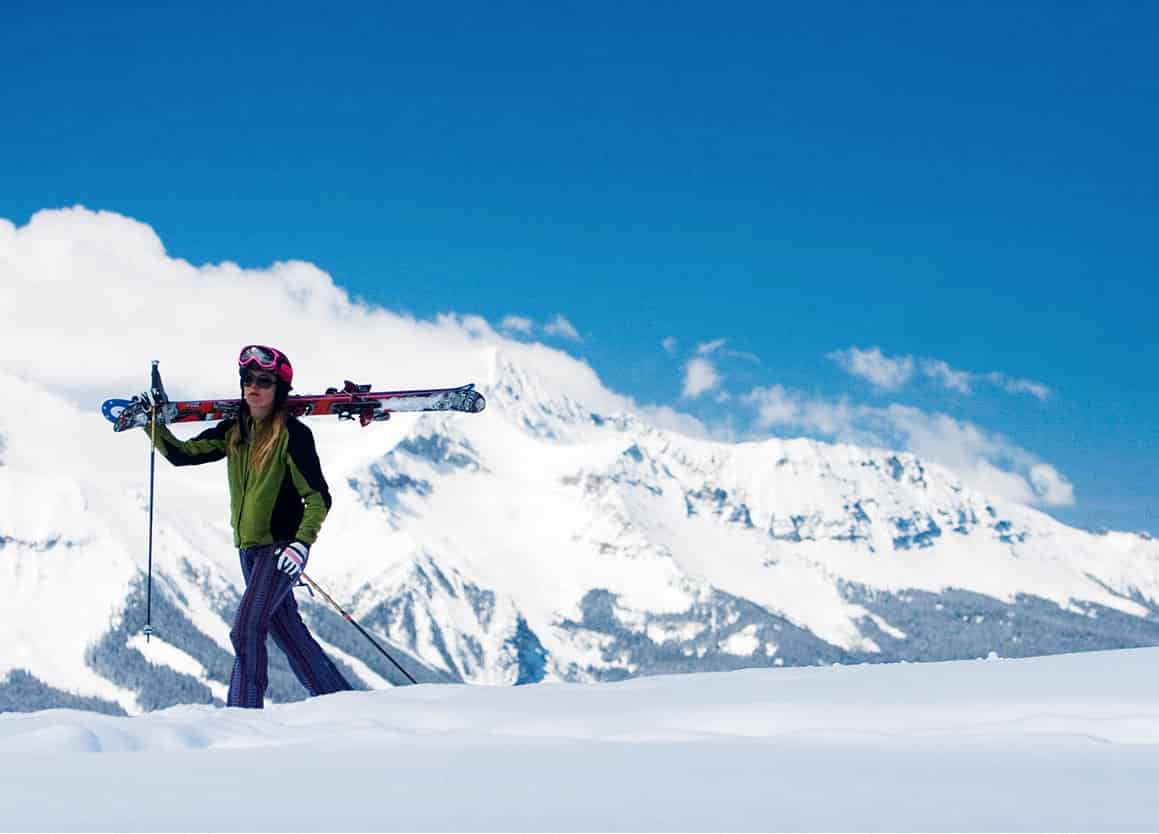
Hiking to the perfect spot high above Telluride.
Colorado Tourism/Matt Inden
Just 25 miles (40km) from Aspen as the crow flies, but an epic drive in winter, is Crested Butte. The enchanting Victorian town nestles in the valley; a separate resort area is set at the base of the lifts. The terrain is varied and quirky, wrapping part-way around a signature peak. Crested Butte offers everything from beginner slopes that are smooth as a table top to some of Colorado’s gnarliest terrain, including an area dubbed Extreme Limits, described by one writer as “a staircase of huge, staggered headwalls that drop off the north side of the mountain.” Though Crested Butte is relatively modest in overall size, an elevation gain of 3,062ft (933 meters) from base to summit puts it in Colorado’s top 10 of vertical drop.
The San Juans
Durango Mountain Resort and Telluride are the top destinations in the snow-rich San Juan Range of southwestern Colorado. Telluride is the name of a gussied-up mining town as well as a nearby ski area, which encompasses a posh development called Mountain Village and an expanded terrain of 2,000 skiable acres (809 hectares) and 120 runs. Linking the old town and Mountain Village is a gondola, affording breathtaking views of the valley and surrounding peaks. Telluride’s expert runs are among Colorado’s most challenging, but its novice and intermediate terrain are top-notch, too.
Family-friendly Purgatory Resort is smaller and far less exclusive than Telluride, with 1,360 skiable acres (550 hectares), 88 trails, 10 lifts, five terrains, and a vertical drop that’s a hair over 2,000ft (600 meters). In 2008, the resort opened its luxury $50-million Purgatory Lodge, anchor for the new Purgatory Village, followed, in 2009, by the unveiling of expanded acreage with 125 acres (50 hectares) of expert terrain. The town of Durango is about 30 minutes away.
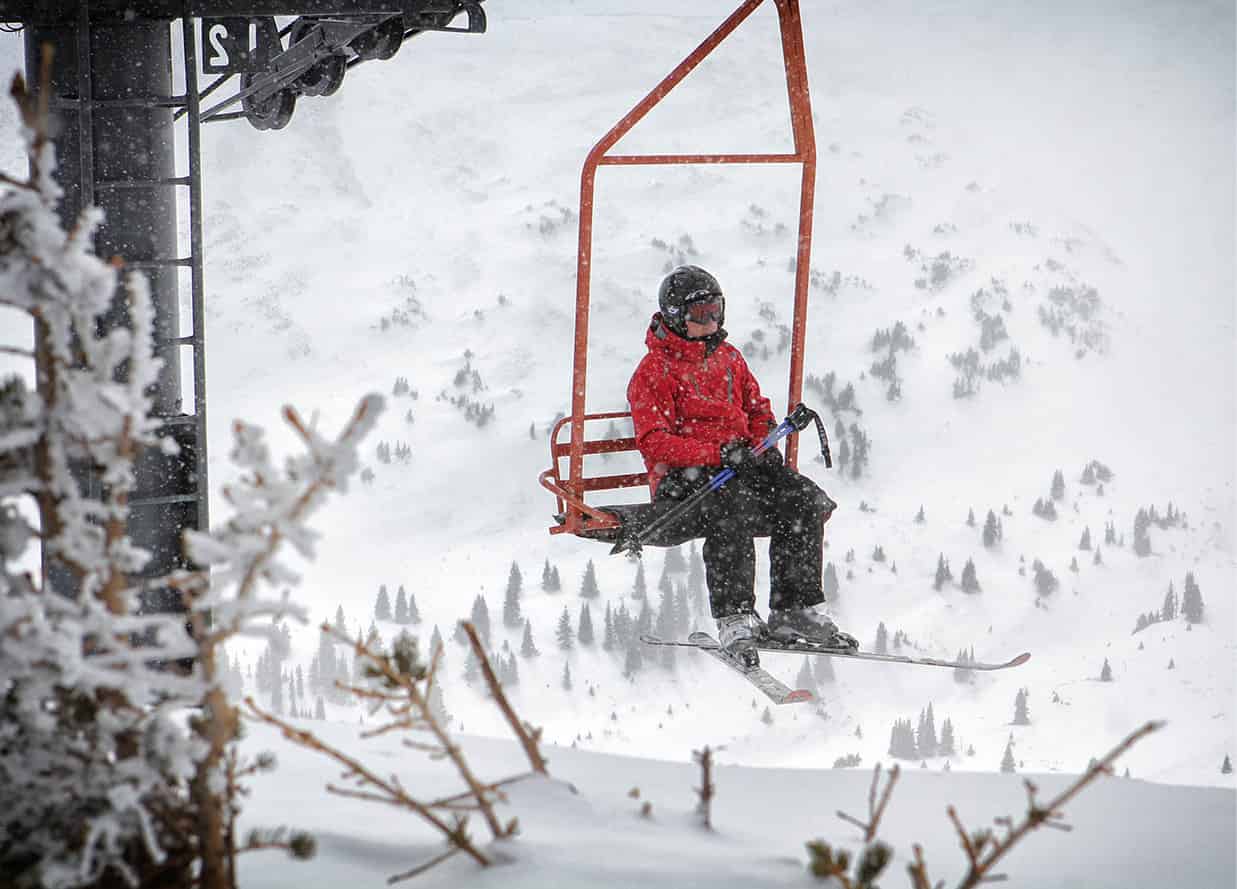
Chair lift at Copper Mountain.
Tripp Fay, Copper Mountain
Lesser-known resorts
In addition to the mega-resorts is an array of mid-sized ski areas, where the prices are reasonable, the atmosphere is low-key and the conditions, while not superlative, are adequate for novice and intermediate skiers. Granby Ranch, for instance, is a pleasant little ski resort north of Winter Park. It consists of an easy hill and an easier hill – a snooze if you’re an experienced skier but a good choice if you’re just learning or traveling with small children. Intermediate skiers and families with school-age children may prefer Sunlight Mountain Resort, near Glenwood Springs, or Powderhorn Resort, on the north side of Grand Mesa, east of Grand Junction.
Just because a ski area is small doesn’t mean it’s not challenging. In fact, some of Colorado’s most exciting slopes are found at half a dozen sites that are short on size but long on action. Five of the six are situated on high passes along the Continental Divide, where snow falls frequently, piles up deep, and lasts late into the season. These areas are ideal for people who miss the ambience of old-time skiing, don’t give a fig about fashion, and prefer snow as nature makes it. They have day lodges instead of slopeside villages, free parking instead of pay lots, and their collective 33 lifts don’t include a single high-speed chair. They’re decent places for beginners, but have plenty to offer intermediate and advanced skiers and snowboarders.
Loveland straddles I-70 about an hour from Denver. It has two pods: Loveland Valley for beginners and the larger Loveland Basin, which has trails woven through evergreens topped by expansive ski-anywhere terrain. Its fixed-grip quad, which unloads at 13,010ft (3,965 meters), is the world’s highest four-place chair-lift.
Just over the west side of Loveland Pass is Arapahoe Basin. With a summit elevation of 13,050ft (3,980 meters), A-Basin is the country’s highest lift-served ski area. A spring-skiing center, the lifts regularly operate into June, often July, and with snow-making finally installed, the season launches in October. Set in a cirque beneath the brow of the Continental Divide, half the ski terrain is above timberline, providing vistas of treeless, craggy peaks etched in high relief against an azure sky. Steep snowfields and relentless chutes give it a reputation as an experts-only area, but milder slopes are available, too. Beginners have free use of the Molly Hogan novice hill at the base.
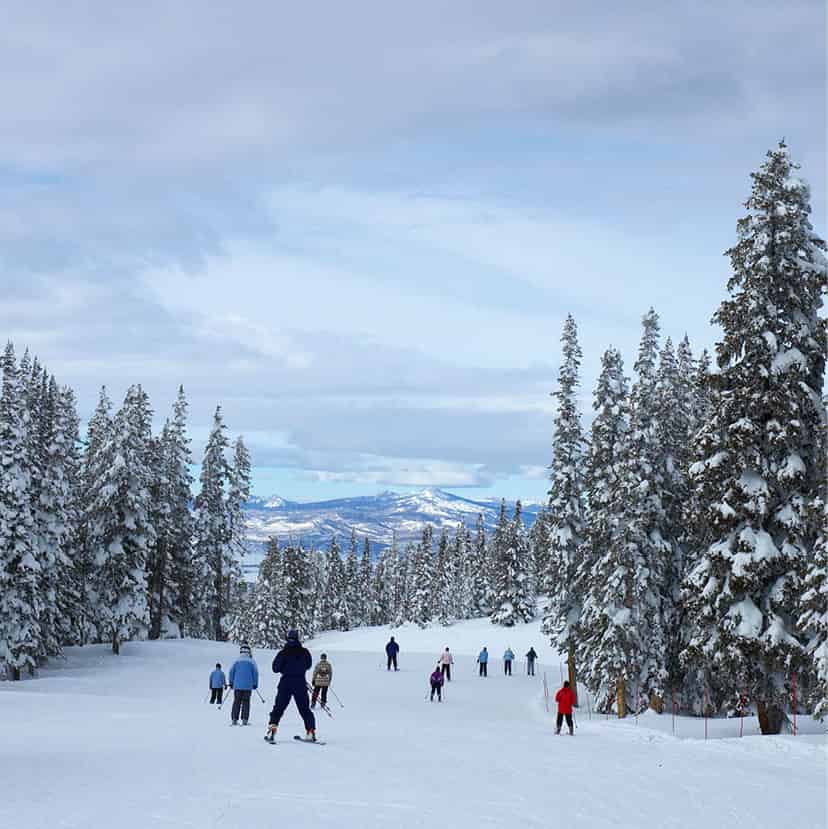
Skiers at Steamboat.
Dreamstime
Situated just east of Monarch Pass, near Salida, the Monarch Ski Area snares an average of 350in (890cm) of powder annually from the “Monarch Cloud.” Nearly all the acreage is skiable, including areas that don’t appear on the trail map – uncharted powder shots through a mature forest of well-spaced pine and fir. A lodge is a couple of miles away, but there are ample accommodations in Salida.
Ski Cooper, which opened as Cooper Hill Ski Area in 1941, high on Tennessee Pass near Leadville, is the true heir to World War II’s Camp Hale. This family-friendly, low-cost ski area remains a rustic outpost of casual, spirited, rarely crowded skiing. The site encompasses 39 runs on two mountain faces with a modest 1,200ft (365-meter) vertical drop. There are four lifts – two longish lifts and two short surface lifts. The front side offers easy to mid-level skiing, with slightly steeper runs on the backside.
Wolf Creek, between South Fork and Pagosa Springs, has a 465in (1,180cm) average annual snowfall, nearly 100in (250cm) more than any other ski area in Colorado save Silverton Mountain. The prodigious powder and laid-back ambience appeal to deep-snow addicts. The area comprises a long ridge that drapes down into mountain top bowls, superlative glades, and wide cruising runs. Advanced skiers and snowboarders seeking a backcountry experience can traverse to Alberta Peak, Step Bowl, and Knife Ridge, true havens of the steep and deep in southern Colorado.
Hometown advantage
The small fry in Colorado’s ski scene are the modest, often municipally owned ski slopes. Many are run by volunteers and open only on weekends and school holidays for the benefit of local youngsters. These include Kendall Mountain in Silverton, Chapman Hill in Durango, and Hesperus between Durango and Mancos.
Among the largest sites in this category is Eldora Mountain Resort in Nederland, 21 miles (34km) west of Boulder, which has 680 acres (275 hectares) of cross-country and downhill skiing as well as snowboarding, and a dozen lifts. Another small ski area that casts a big shadow is Steamboat Springs’ Howelsen Hill. It is the town’s main winter amenity, offering night skiing, ski jumping, freestyle and race training, cross-country skiing, and ice-skating – all at a rock-bottom price. If you ski Steamboat and want to meet the locals, including a few candidates for the US Ski Team, Howelsen Hill is the place to be.
Despite their diminutive size, these local ski hills are guardians of Colorado’s ski legacy, and they are just as important as the giant resorts that pull in millions of skiers and riders from around the world.
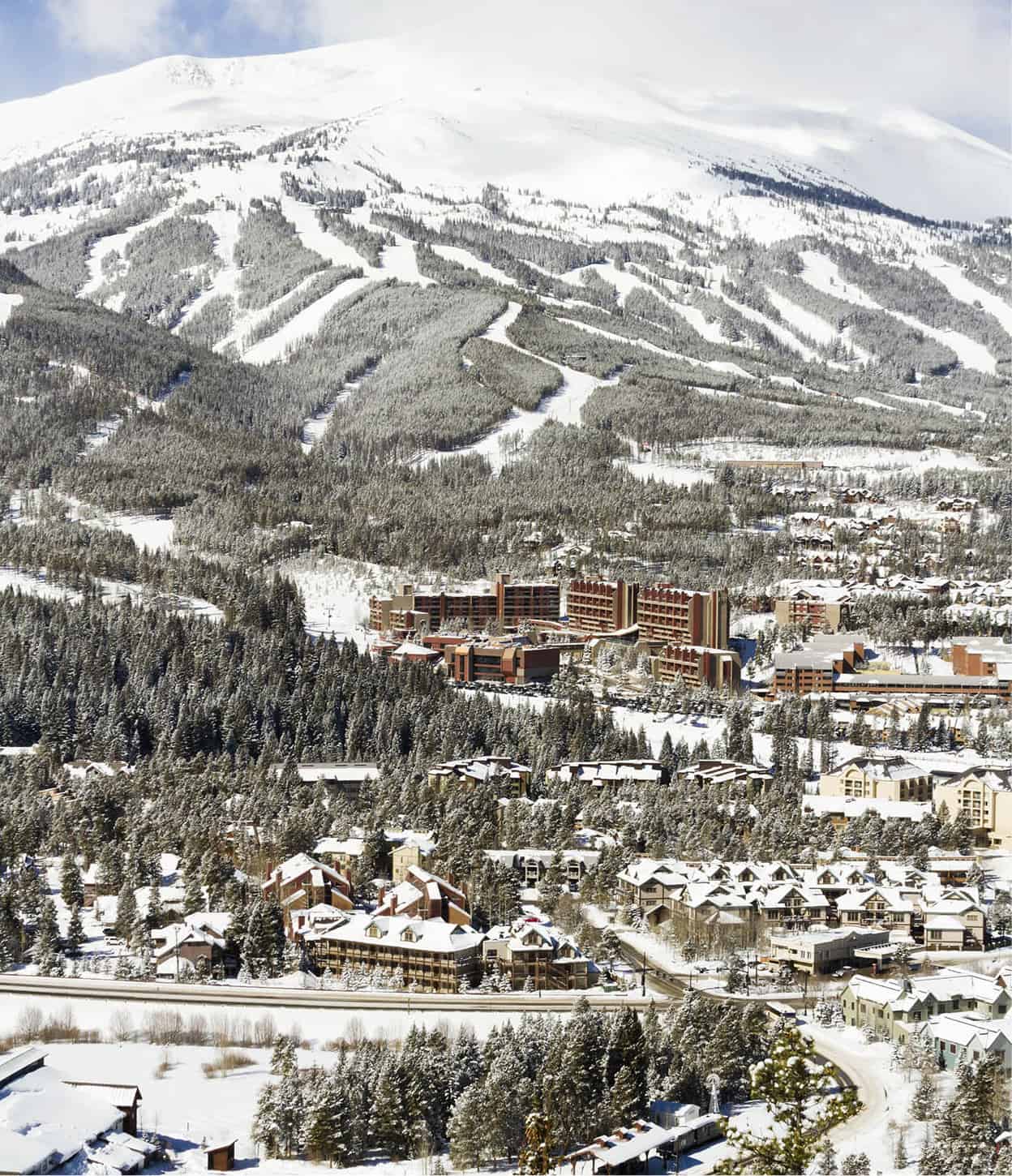
View of Breckenridge.
123RF